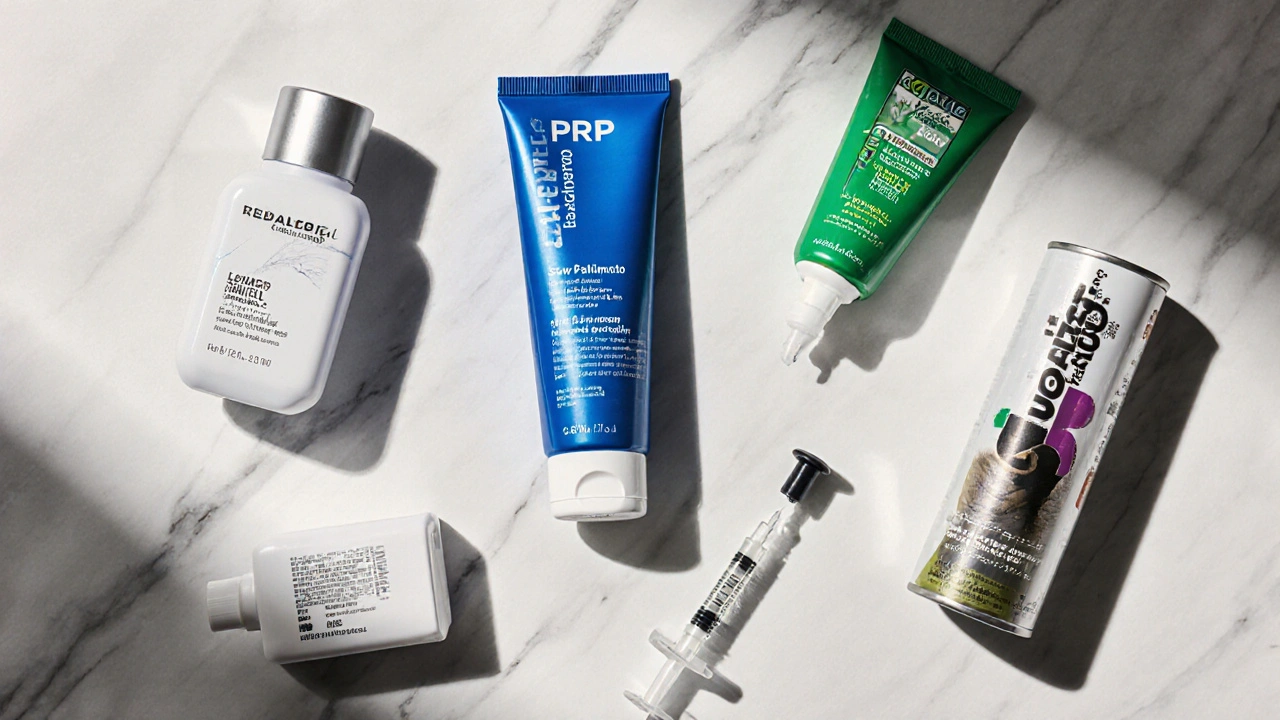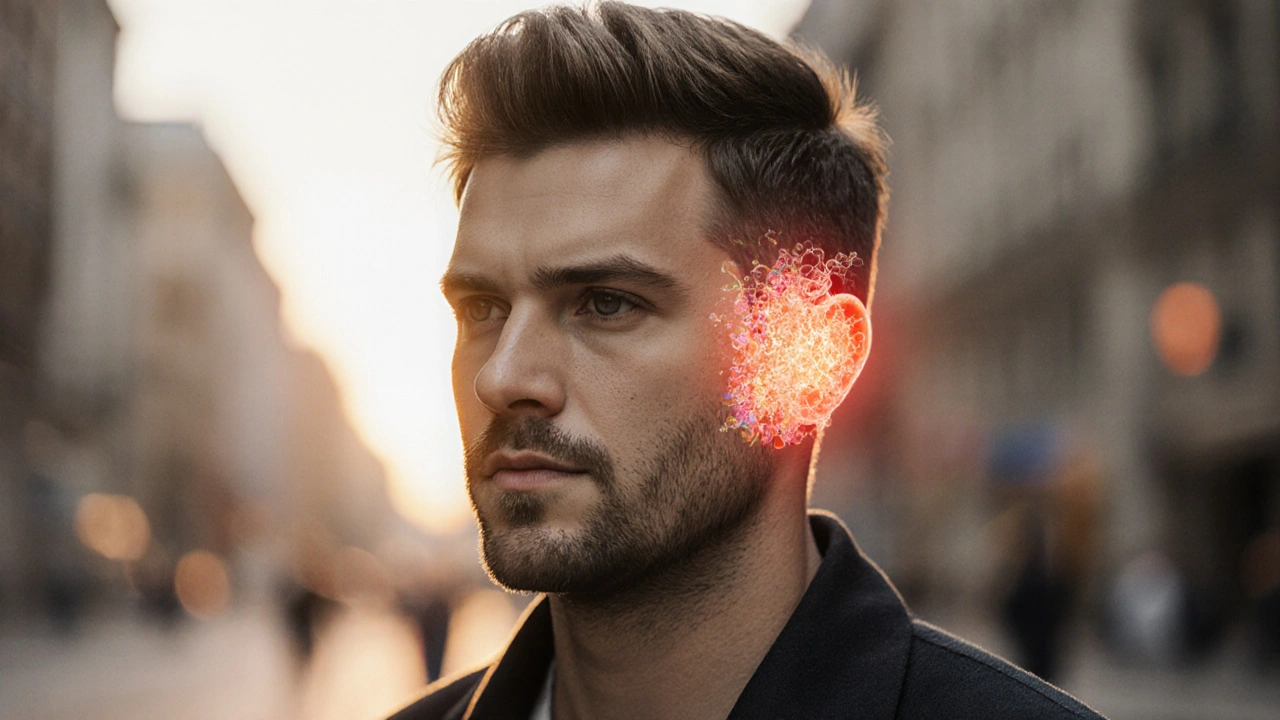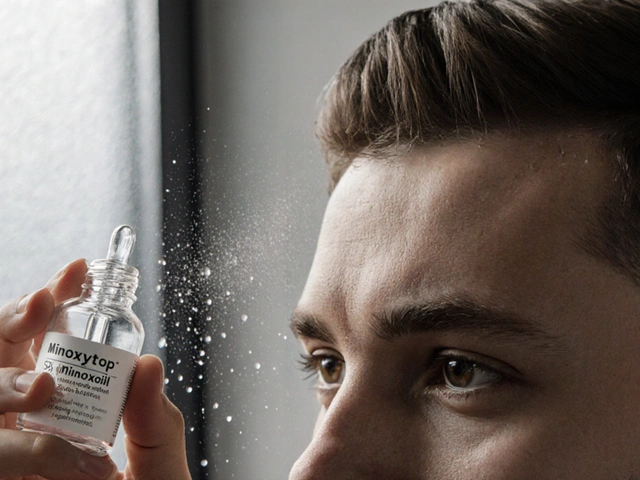Hair Loss Treatment Matchmaker
Find Your Best Hair Loss Treatment
Answer these questions to get personalized recommendations based on clinical data from our comprehensive comparison guide.
1. What's your budget for monthly treatment?
2. How do you feel about side effects?
3. How much time can you commit daily/weekly?
4. What stage of hair loss are you experiencing?
Personalized Recommendations
Based on your selections, here are your best options:
These treatments match your criteria and have been shown to provide the best results for your specific situation.
Why these treatments?
Each recommendation is based on clinical data from our comparison guide. Treatments are scored based on:
- Effectiveness for your hair loss stage
- Compatibility with your budget
- Side effect profile matching your tolerance
- Time commitment requirements
When it comes to tackling thinning hair, Minoxytop is a topical solution that delivers 5% minoxidil to the scalp to stimulate hair follicles and extend the growth phase. Many people wonder how it stacks up against other options like oral finasteride or laser devices. This guide breaks down the science, costs, and real‑world results so you can decide which route fits your budget and lifestyle.
Quick Takeaways
- Minoxytop works best for early‑stage pattern baldness and requires daily use.
- Oral finasteride offers strong results for men but carries hormonal side‑effects.
- Ketoconazole shampoo (e.g., Nizoral) helps by reducing scalp inflammation.
- Low‑Level Laser Therapy provides a drug‑free option but needs consistent sessions.
- Cost per month varies widely: from under $15 for Minoxytop to $300+ for laser caps.
How Minoxytop (Minoxidil) Works
Minoxytop’s active ingredient, minoxidil, was originally developed as a blood‑pressure drug. Researchers later discovered it widened blood vessels in the scalp, delivering more oxygen and nutrients to dormant hair follicles. The result is a longer anagen (growth) phase and the recruitment of new follicles.
Typical usage: apply 1ml to the affected area twice a day, let it dry, and avoid rinsing for at least four hours. Consistency matters-most users see visible thickening after 12‑16 weeks, but stopping treatment quickly reverses gains.
Top Alternatives to Minoxytop
Below are the most common competitors, each introduced with a short definition.
Finasteride is an oral prescription medication that blocks the conversion of testosterone to dihydrotestosterone (DHT), the hormone primarily responsible for male‑pattern hair loss.
Rogaine (brand name) is a 5% minoxidil solution identical in active ingredient to Minoxytop but marketed under a different label, often with added promotional packaging.
Nizoral is a 2% ketoconazole shampoo that reduces scalp fungal overgrowth and inflammation, indirectly supporting hair‑growth cycles.
Saw Palmetto is a plant extract used in some topical formulas; it is thought to inhibit DHT locally without systemic hormone changes.
Low‑Level Laser Therapy (LLLT) devices emit red light (630‑660nm) that stimulates cellular metabolism in hair follicles, encouraging thicker growth.
Platelet‑Rich Plasma (PRP) therapy involves injecting a concentration of a patient’s own platelets into the scalp, delivering growth factors that can reactivate dormant follicles.

Side‑Effect Profile
Understanding the safety landscape helps avoid unpleasant surprises.
| Product | Common Side‑Effects | Serious Risks |
|---|---|---|
| Minoxytop | Scalp itching, dryness, mild redness | Rare systemic absorption causing low blood pressure |
| Finasteride | Reduced libido, mild erectile dysfunction | Potential persistent sexual dysfunction, rare breast tenderness |
| Rogaine | Same as Minoxytop | None beyond Minoxytop’s profile |
| Nizoral | Scalp irritation, dryness | Rare allergic reaction |
| Saw Palmetto | Minimal; occasional skin irritation | None documented in topical use |
| LLLT | Eye strain if not wearing protective goggles | None known |
| PRP | Temporary redness, mild swelling | Infection risk if sterile technique fails |
Cost Comparison
| Product | Average Monthly Price | Typical Treatment Duration | Insurance Coverage |
|---|---|---|---|
| Minoxytop | $12‑$18 | Ongoing | Rarely covered |
| Finasteride (1mg) | $30‑$45 | 12‑24months | Often covered |
| Rogaine (5% foam) | $15‑$25 | Ongoing | Rarely covered |
| Nizoral Shampoo | $8‑$12 (per bottle, lasts ~1month) | 2‑3months, then maintenance | Occasionally covered for skin conditions |
| Saw Palmetto Topical | $10‑$20 | Ongoing | Not covered |
| LLLT Device (cap) | $250‑$350 (one‑time) | 6‑12months to see benefit | Never covered |
| PRP Session | $400‑$800 per session | 3‑4 sessions, then as needed | Rarely covered |
Effectiveness Snapshot
Clinical data and real‑world surveys give us a rough ranking of how well each option actually regrows hair.
| Product | Average Hair‑Count Increase (6months) | Patient Satisfaction (%) |
|---|---|---|
| Minoxytop | +15% to +30% | 68 |
| Finasteride | +30% to +45% | 78 |
| Rogaine | +12% to +28% | 65 |
| Nizoral Shampoo | +5% to +12% | 55 |
| Saw Palmetto | +8% to +15% | 60 |
| LLLT | +10% to +25% | 62 |
| PRP | +25% to +40% | 70 |
How to Choose the Right Option
Consider the following decision criteria:
- Stage of hair loss: Early thinning responds well to minoxidil‑based products; advanced recession may need systemic therapy (finasteride) or procedural interventions (PRP).
- Medical history: Men with prostate concerns should discuss finasteride with a doctor. Women often avoid finasteride because of teratogenic risk.
- Budget: If you want a low‑cost daily routine, Minoxytop or a generic minoxidil foam fits. High‑end devices or PRP are better for those with flexible spending.
- Commitment level: Topical solutions demand twice‑daily application; laser caps need 15‑30minutes each session; PRP requires clinic visits.
- Side‑effect tolerance: If you’re sensitive to scalp irritation, a ketoconazole shampoo or oral finasteride may be gentler.
By scoring each factor, you can narrow the list to one or two contenders before consulting a dermatologist.

Pros and Cons at a Glance
| Product | Pros | Cons |
|---|---|---|
| Minoxytop | Proven over‑the‑counter, easy to buy, modest cost | Must be used daily, results fade if stopped |
| Finasteride | High efficacy, once‑daily pill | Potential hormonal side‑effects, prescription only |
| Rogaine | Same active ingredient, foam format may feel lighter | Same adherence issue as Minoxytop |
| Nizoral Shampoo | Addresses scalp health, low cost | Limited regrowth alone, needs regular washing |
| Saw Palmetto | Natural, minimal systemic exposure | Evidence less robust than minoxidil |
| LLLT | Drug‑free, no topical mess | High upfront cost, needs consistent use |
| PRP | Potential for strong regrowth, works on advanced loss | Expensive, requires clinic visits |
Real‑World Example
John, a 34‑year‑old accountant from Nottingham, started with Minoxytop at age 28. After six months he saw 22% more hairs in the crown area. When loss progressed at the hairline, his dermatologist added a low dose of finasteride. Within a year John reported a total improvement of about 35% compared to baseline. The key takeaway: many users combine a topical minoxidil product with an oral DHT blocker for synergistic effect, but only under medical supervision.
Final Thoughts
If you’re deciding between Minoxytop and its rivals, ask yourself: how much hair have I lost? Am I comfortable with daily application or prefer a one‑time device? What’s my budget? By answering these, you’ll land on the option that offers the best balance of efficacy, safety, and cost for your unique situation. Whatever you choose, consistency is the secret sauce-most therapies need months of steady use before you can celebrate real growth.
Minoxytop remains a solid first‑line choice for many because it’s affordable, widely available, and backed by decades of data. Pair it with professional guidance, and you’ll give your hair the strongest possible chance to come back.
Frequently Asked Questions
Can I use Minoxytop and finasteride together?
Yes, many dermatologists prescribe both. Minoxytop works locally on the scalp, while finasteride reduces DHT systemically. Combining them can boost overall hair‑count gains, but you should monitor for side‑effects and get regular check‑ups.
Is Minoxytop safe for women?
Minoxytop is labeled for both men and women, but women should use the 2% formulation if available, as the 5% concentration can increase scalp irritation. Pregnant or nursing women should avoid minoxidil altogether.
How long does it take to see results with Minoxytop?
Most users notice the first signs of thicker hair between 12 and 16 weeks. Peak results are usually observed after about 6 months of uninterrupted use.
What’s the main difference between Minoxytop and Rogaine?
Both contain 5% minoxidil. The difference lies in branding, packaging, and sometimes the included inactive ingredients. Clinically they perform the same, so price or personal preference often decides the choice.
Can laser therapy replace minoxidil?
Laser therapy can help, especially for those who dislike topical solutions, but studies show it’s generally less effective than minoxidil alone. Many users combine both for additive benefits.


Julien Martin
Great rundown of the minoxidil landscape-especially the breakdown of dosage frequency and scalp‑vascular dynamics. The way you juxtaposed cost per month with the pharmacokinetic profile really helps readers visualize trade‑offs. For early‑stage thinning, the data suggests Minoxytop’s 5% solution hits the sweet spot between efficacy and tolerability. Keep the comparison tables coming, they’re gold for anyone mapping out a budget‑conscious regimen.
Lolita Rosa
Wow, this guide feels like a love letter to American ingenuity in hair‑care! From the swagger of a laser cap to the humble foam of Rogaine, it showcases the nation's endless hustle. Nothing beats the pride of a home‑grown solution that can be bought off the shelf without a pharmacy visit. The patriotism of supporting local manufacturers shines through every cost table.
Matthew Platts
Totally agree, the cost vs. benefit matrix is clutch. If you stick to the twice‑daily routine, those numbers become way more manageable. Just remember consistency is the real MVP here.
Kasey Mynatt
Seeing the side‑effect profiles side by side really clarifies the risk hierarchy. For anyone worried about scalp irritation, opting for the 2% formulation, especially for women, can sidestep that redness while still delivering follicular stimulation. The guide’s note on systemic absorption being “rare” for Minoxytop helps calm the anxiety of over‑the‑counter users. Also, the inclusion of a “budget” column gives a realistic picture-no one wants to be blindsided by hidden costs like replacement tips for laser caps. If you’re in the moderate commitment bracket, the daily foam might feel less invasive than a weekly PRP session that drags on your calendar. Finally, the FAQ section nails the most common myths, particularly the misconception that laser therapy outright replaces minoxidil; the evidence still points to a combined approach for maximum density gains. Keep sprinkling these practical tips, they’re the bridge between clinical data and everyday life.
Edwin Pennock
Honestly, the guide glosses over the hidden price tags on some “premium” options. Sure, Minoxytop is cheap, but you still need a good dispenser and possibly a separate moisturizer to combat dryness-those add up. Meanwhile, the laser caps boast a “one‑time” fee, yet the electricity usage and occasional bulb replacements are an ongoing expense most people ignore. It feels like the data leans too much toward the low‑budget narrative without acknowledging the total cost of ownership.
John McGuire
Hey folks, loving the depth here! 🙌 If you’re on a budget but still want solid results, start with Minoxytop and track your progress with weekly photos. 📸 Pair it with a gentle ketoconazole shampoo for scalp health, and you’ll boost the minoxidil’s efficacy without extra side effects. Remember, consistency is key-don’t skip those two daily doses! 🌱 Stay motivated, the hair will thank you.
newsscribbles kunle
While the enthusiasm is refreshing, let’s not forget the responsibility we have to promote safe practices. Pushing over‑the‑counter treatments without stressing the need for dermatologist supervision can lead to misuse, especially in younger users. Ethical guidance should always underscore a professional check‑up before committing to any regimen.
Bernard Williams
The comprehensive comparison you’ve presented does an admirable job of synthesizing a sprawling literature base into an accessible format for lay readers. By aligning each treatment’s mechanism of action with its stage‑specific efficacy, you empower individuals to make evidence‑based decisions rather than relying on anecdotal hype. For example, the way you highlighted finasteride’s inhibition of the 5‑alpha‑reductase enzyme provides a clear biochemical rationale for its superior performance in moderate to advanced androgenetic alopecia. Simultaneously, you didn’t shy away from discussing the controversial nature of its hormonal side effects, which remains a critical consideration for many patients. The inclusion of cost trajectories-both monthly and one‑time expenditures-adds a pragmatic layer that often gets overlooked in purely clinical reviews. Moreover, the side‑effect matrix, presented in a succinct table, allows quick scanning of tolerability profiles, which is especially valuable for users with sensitive scalps. Your decision‑making framework, which scores treatments across budget, side‑effect tolerance, time commitment, and stage of loss, serves as a practical decision‑tree that can be readily adapted to individual preferences. The real‑world case study of John from Nottingham exemplifies how combination therapy can be tailored to address both early thinning and receding hairlines, reinforcing the notion that personalized regimens often outperform monotherapy. Additionally, the FAQ segment pre‑emptively addresses common misconceptions, such as the erroneous belief that laser therapy can singularly replace minoxidil, thereby correcting misinformation that circulates on social media platforms. The balanced tone throughout the guide-neither overly promotional nor dismissive-helps maintain credibility while still encouraging proactive management of hair loss. Finally, the call for consistency as the “secret sauce” resonates with the broader principle that most dermatologic interventions require sustained application to achieve and maintain results. Overall, this guide stands out as a valuable resource that bridges the gap between academic research and everyday consumer decision‑making, and it sets a high standard for future comparative health articles.
Amy Robbins
Wow, that was a novel‑length dissertation for a Reddit post-did you secretly copy a journal article? 😉 Still, if you can squeeze all that jargon into a single paragraph, maybe the average reader will just skim and miss the point entirely.
Shriniwas Kumar
From a pharmacodynamic perspective, the synergy between minoxidil’s vasodilatory effect and finasteride’s androgen receptor blockade creates a multi‑pronged therapeutic axis. The interplay of nitric oxide‑mediated follicular angiogenesis with reduced dihydrotestosterone levels optimizes the anagen phase duration. Incorporating adjunctive agents like ketoconazole adds an anti‑inflammatory vector, attenuating perifollicular cytokine cascades that otherwise impede hair shaft elongation.
Sudha Srinivasan
Check the facts – minoxidil isn’t a miracle cure, and finasteride isn’t for women. Keep it simple: use what works for you, don’t overcomplicate.
Jenny Spurllock
The guide’s holistic approach really resonates, especially the emphasis on monitoring progress over time rather than expecting overnight miracles. Visual documentation paired with realistic expectations can keep motivation high during the lag phase.
Bart Cheever
Honestly, this is just a rehash of stuff we’ve seen a hundred times.
Maude Rosièere Laqueille
Thanks for laying out the insurance coverage nuances-many patients overlook that finasteride often gets reimbursed while topical solutions don’t. Having that clarity upfront can prevent surprise out‑of‑pocket expenses down the line. Also, the tip about rotating between foam and liquid formulations to mitigate scalp dryness is a practical nugget that isn’t commonly discussed.
Jessica Haggard
Glad you liked the insurance tip! It’s crazy how many people assume everything over the counter is free, but the paperwork can be a nightmare if you don’t know which codes to use.
Alan Clark
Super helpful guide, mate! The cost breakdown helped me decide to stick with the 5% foam instead of splurging on a pricey laser cap. Gotta love a solid plan that doesn’t break the bank.
Mark Anderson
Exactly! The clear tables make it easy to compare, and the friendly tone keeps it from feeling like a sales pitch. Can’t wait to see a follow‑up with newer treatments coming out.